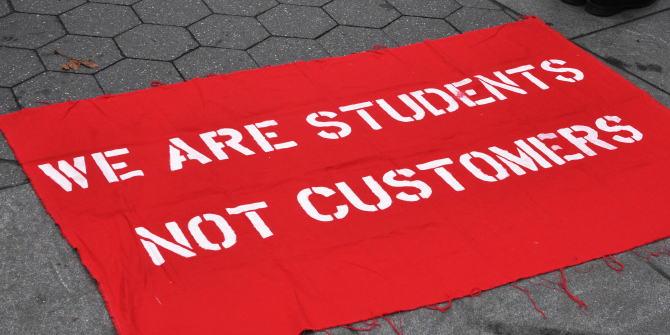In Indebted: How Families Make College Work at Any Cost, Caitlin Zaloom draws on more than 160 interviews with college students and their families to explore how middle-class households in the US pay for university. This is a timely and accessible study that breaks through the taboo surrounding family finances, making useful sociological points not only about the cost of higher education, but also about the nature of middle-classness today, writes Chloe Reid.
Indebted: How Families Make College Work at Any Cost. Caitlin Zaloom. Princeton University Press. 2019.
 Find this book (affiliate link):
Find this book (affiliate link): ![]()
Laura and Chris are the proud parents of Sam and Mark who respectively attend Western Michigan University and Grand Valley State University in the US. Whilst Sam and Mark utilise federal loans of $7,500 and $5,500 each year, Laura takes on additional nursing shifts and her father had a second job to support the boys financially. Laura’s father also helped Sam and Mark with the cost of college by giving the boys $20,000 from the proceeds of the sale of his property. This is accompanied by a college savings plan that Laura’s parents started when the boys were small. To keep track of how this hard-earned money is spent, Laura has a spreadsheet for each son, recording how much each book cost, room and board, how many credit hours they’ve taken and so on. For this family, paying for college is a three-generation effort.
The issue of how US middle-class families pay for college is at the heart of Caitlin Zaloom’s new book, Indebted. She details the results of a four-year study, comprising of more than 160 interviews with college students and their families at private and public higher education (HE) institutions. As she discusses in the book, it was difficult to recruit interview participants because of the widespread reluctance to discuss money. ‘Sex, politics, religion – Americans are far more likely to discuss these sensitive topics with friends, neighbours and relatives than they are to share information about how much money they make, save and owe’ (21). For Zaloom, it is important to bring these private discussions about money into public view.
Zaloom herself is Associate Professor of Social and Cultural Analysis at New York University and has previously written the book, Out of the Pits: Traders and Technology from Chicago to London. In Indebted, she provides a comprehensive and compelling description of the US student finance system. Zaloom defines the issue of what comprises middle-classness precisely by the capacity to pay for college. These families may not be able to afford the full fare, but they also do not qualify for grants.
For these families, their lives are organised around the problem of paying for college, because they believe HE will give their children an ‘open future’ and ‘opportunities that will allow them to fulfil their potential’ (6). This preparation begins at a young age, with the parents of a two-year-old spending considerable time and energy planning how to fund their education. Such time and effort means that the families in Indebted must speculate whether college will indeed ‘pay off’ for their children.
 Reports have described how some graduates may be faced with the issue of underemployment after leaving college. Of course, there are important social and personal benefits to university education. However, Zaloom suggests that the US emphasis on loans and finding a well-paid job means that the value of higher education is primarily seen as financial. Do college graduates and their families, who have put considerable time and effort towards affording college, believe this was well-spent? This is an area the book could have explored in more detail.
Reports have described how some graduates may be faced with the issue of underemployment after leaving college. Of course, there are important social and personal benefits to university education. However, Zaloom suggests that the US emphasis on loans and finding a well-paid job means that the value of higher education is primarily seen as financial. Do college graduates and their families, who have put considerable time and effort towards affording college, believe this was well-spent? This is an area the book could have explored in more detail.
Aside from this, Indebted evokes sympathy for students and their families in their aim to meet the challenges of affording a college education. Zaloom describes how the cost of tuition and fees for in-state students at public universities has risen more than threefold since 1987, with private colleges costing more (13). Even for those who have chosen to invest in a college savings programme, they may still struggle as college costs have sky-rocketed since they began saving.
Within the book, there is a discussion of how parents’ faith that their offspring will attend college is key to their middle-classness. Parents assess their child’s potential ‘like accountants’ (45), and investing is seen as an ‘expression of how much they care’ (34). As a reader, this evokes questions about what impact this pressure has on children. One must wonder how much choice and freedom a young person may feel about their future if their parents have been assessing their potential and saving for their college education since birth.
As well as college, parents must also save for their own retirements. This leads parents to ask themselves: ‘just how likely is my child to graduate from college? Does it make sense to take the risk of devoting my savings to that possibility?’ (45). Again, this brings questions to my mind as to whether there are scenarios whereby a parent has decided their child is unlikely to flourish in HE, but the young person decides that they want to attend.
Even for families who agree that their child should pursue college, it is apparent in Zaloom’s book that finance may limit student choice of where they attend. Zaloom describes how one mother told her son ‘he would attend the school in which the most robust aid package gave him access to the most prestige, and that he could not attend schools outside of New York City’ (160). This seems to be a missed opportunity to discuss the implications for meritocracy that arise from the US college finance system. If a US student’s access to college is limited by finance and not their own ability, is the system meritocratic?
It is a truism that not all middle-class students and their families are the same because some will face greater challenges. The chapter ‘Race and Upward Mobility’ provides an illuminating account of the story behind historically black colleges and universities (HBCUs) and why this is crucial for understanding modern African-American experiences of education and social mobility. It is a troubling statistic that black students carry almost 70 per cent more debt than white students. Historical discrimination has left many African-American families with limited assets and weaker credit ratings, meaning that they are more likely to be denied loans.
The book ends with a stirring and important reminder that college is not just an investment, but also creates the possibility of intellectual growth and unconstrained potential. Zaloom therefore calls for a system of student finance that is more generous and not as complex as the current provision. This would recognise that education is an investment in the nation’s future and would aid students in being more capable of making crucial life decisions about their degrees and careers.
Finance is sometimes regarded as a taboo and difficult topic. However, Zaloom has produced a book that is accessible to those without a prior understanding of economics. In addition to the discussions around finance, she makes useful sociological points about the nature of middle-classness and the intrinsic obligations held by family members. Overall, it is a timely book and may be of interest to all parents and students preparing for entry to HE.
Note: This review gives the views of the author, and not the position of the LSE Review of Books blog, or of the London School of Economics. The LSE RB blog may receive a small commission if you choose to make a purchase through the above Amazon affiliate link. This is entirely independent of the coverage of the book on LSE Review of Books.
Image Credit: 3D Animation Production Company from Pixabay. 3D graphics image by Quince Creative.







